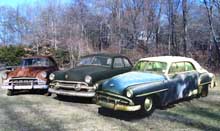The Low-Priced Three
Alfred P. Sloan's doctrine of "a car for every purse and purpose" was firmly entrenched by the early 1930s. General Motors had a clear cascade of makes, from Cadillac at the top of the market to Chevrolet at the bottom. Walter Chrysler recognized the phenomenon, which led him to introduce price-leader Plymouth to balance his namesake Chrysler. Henry Ford, whose name was synonymous with economy, left his own car at the bottom, forsaking the marquee position to Lincoln. Chevrolet, Ford and Plymouth, then, came to be known as the "Low-Priced Three," the place where a family of modest means would begin their car shopping.
The landscape was well established. In 1932, a Pontiac Six cost 22 percent more than a Chevy (based on the proverbial lowest-priced four-door sedans), a DeSoto 43 percent more than a Plymouth PB (Dodge cost more than DeSoto in 1932, remember). Ford's bigger brother, Lincoln, didn't really figure into this theory, as at $3,200 it was mega-times the cost of a $540 Model B Ford (this car was owned by my parents before my time - the children playing are my older cousins Becky and Ben).
In 1940, things hadn't changed much. The "Pontiac premium" over Chevy had risen to 25 percent, Dodge, now the lower-middle Mopar, cost 15 percent more than Plymouth, and Ford had a middle sibling, Mercury, that cost 32 percent more. In 1950 the Pontiac-Chevy margin was down to 18 percent, Mercury-Ford difference had risen to 38 percent and Dodge kept its 15 percent lead over Plymouth.
The Sixties changed all that. The new compact cars from the Big Three, Corvair, Falcon and Valiant, entered their companies' price ladders at the bottom, commanding 12 to 15 percent less than "full size" cars. There were no Pontiac or Dodge compacts, and Mercury's Comet arrived late in the year, priced just four percent more than a Falcon. Among the big cars, the Pontiac cost 16 percent over Chevy and Mercury was 19 percent more than Ford. But something ominous happened at Dodge. The new Dodge Dart Seneca cost less than one percent more than a full-sized Plymouth. When Dodge got a Valiant-clone, the Lancer, in 1961, its price premium was a scant one percent.
The tide had turned. Twenty years later, Pontiac's margin over Chevy (model for model, Phoenix vs. Citation - there was no analog to the Chevette) was four percent. When the Pontiac T1000 came in 1981, its Chevette premium was but two percent. Mercury's Zephyr cost only three percent more than a Ford Fairmont (though Bobcat's margin over Pinto was a hefty 16 percent), while the Dodge Aspen and Plymouth Volare were actually priced the same. In fact, so were the Dodge Omni and the Plymouth Horizon.
The Big Three were not the only manufacturers to offer entry-level cars. Independents had them, too, though no single maker offered them consistently. In 1932, Hudson's Terraplane (christened by aviatrix Amelia Earhart) sold for ten dollars more than a Ford or Plymouth, forty dollars less than a Chevy. The low priced insurgent in 1940 and 1950 was the Studebaker Champion, and in 1960 the Rambler American cost less than any of the Big Three compacts. Studebaker attempted inroads with the super-plain Scotsman in 1957-58 and the newly-shortened Lark made some headway in 1959. AMC came up with another price-leader, the ex-Gremlin $4,515 Spirit in 1980.
Fast-forward to 2001. Pontiac Sunfire had a Sloan-like margin of eight percent over the Chevy Cavalier. Mercury had nothing competing with Ford's Focus, its cheapest car, the Sable, costing five percent more than a Taurus. Dodge and Plymouth were competing with Neons that differed only in their badge decals; their price stickers were still exactly the same. With hindsight, we can opine that Plymouth was doomed a full forty years earlier by Chrysler's rejection of Sloanism. And the Low-Priced Three? There were three 2001 cars sold in the US priced under $11,000. They were made by Kia, Hyundai and Toyota.

